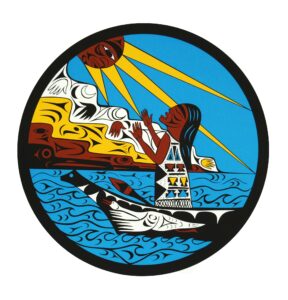On Sunday, February 25, Mark Loria will be giving a lecture on contemporary Indigenous art of Vancouver Island as part of the Art Gallery of Greater Victoria’s Sunday Art Lecture Series. Loria has the experience to talk about the subject: The Mark Loria Gallery, located on Fort Street, opened over 40 years ago. Originally under the care of an Australian woman, Elaine Monds, the initial focus was on Australian Indigenous artwork—but as Monds built more local relationships, the art shifted to reflect that local history.
Mark and his wife Mary took over the gallery in 2018, and while they’re not Indigenous, they’ve done a huge amount of work to collaborate with and uplift Coast Salish nations.

“When we took over the gallery I was very good friends with… TEMOSENŦET, Charles Elliott, who just passed away last year, from the T’sartlip First Nation,” says Loria. “[I had] lots of discussions with him when we took over the gallery, and he and his brother, John Elliott, smudged the gallery and invited us and gave us responsibility to operate the gallery here in 2018… I was reminded a few weeks ago to call myself an invited guest at this point, moving past from uninvited guests.”
The honour of being invited comes with the weight of relationship and understanding of culture. Because of this, the Mark Loria Gallery operates a little differently than most other commercial galleries.
“We’re more like a collection, so we don’t have contracts with any of the artists. They are open to work with us if they choose to,” says Loria. “We’ve worked with about 50 artists on an ongoing basis. But they can acquire their own commissions, we can help them get commissions, they can work with other galleries, which they do. And we also purchase art upfront for the most part instead of consigning, so it is more like a local collection of northwest coast and Coast Salish art.”
Loria has experience managing high-profile artistic spaces and taking part in the careful research of Indigenous nations’ histories, and he knows the importance of respectful and uplifting relationships with Indigenous artists.
“My background is in art, I have a degree in Fine Art from the University of Calgary and I studied printmaking,” he says. “And growing up in Calgary, I was fascinated with Indigenous culture. I spent a lot of time as a student studying the Blackfoot collection at the Glenbow Museum. I was very familiar early on with Sixties Scoop residential schools because I had Indigenous friends in Calgary. So as an artist and art worker I’ve been very conscious of the true history of Canada. I’ve always worked to, as much as I could, be involved with Indigenous art and culture.”
Loria says there are unique aspects of Indigenous art in an Indigenous and a non-Indigenous landscape.
“In the languages of the northwest coast, there isn’t a word for art… Everything comes from life and ceremony, totems, dance masks, paddles, canoes… Once you learn a small amount, you realize that this is a visual language,” he says. “And if it’s not done the right way, not only is it extremely offensive, but it’s just not important. It’s not valid, it’s not art. So we really have to discuss what makes up the visual language for each territory.”
At the end of the day, everything comes back to the fulfilment and prosperity of the Indigenous people he works with.
“Indigenous people are still repressed. For me, really, the art is secondary,” says Loria. “You can get out there, you can support Indigenous artists. They’re looking for assistance, not just financially, but getting projects done, getting exhibitions up… I want to see Indigenous artists being successful; I want to see their nations being successful.”
Contemporary Indigenous Art of Vancouver Island
2 pm Sunday, February 25
$30, Art Gallery of Greater Victoria
aggv.ca
